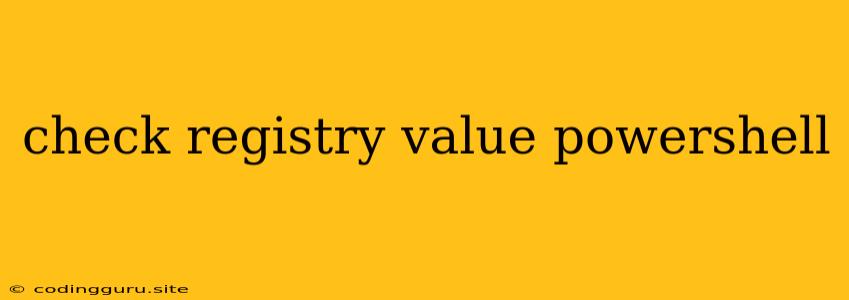Checking Registry Values with PowerShell
PowerShell is a powerful scripting language that allows you to interact with and manage your Windows operating system in a variety of ways. One of the most common tasks is to work with the Windows Registry, a hierarchical database that stores system configuration settings.
This article will guide you through the process of checking registry values using PowerShell. We'll cover the basics of using PowerShell cmdlets to read and access registry data, explore various methods for retrieving registry values, and provide examples to illustrate the concepts.
Why Check Registry Values?
Understanding how to check registry values is crucial for a number of reasons:
- Troubleshooting System Issues: Often, issues with applications or system settings can be traced back to incorrect or missing registry entries.
- Configuration Management: You can use PowerShell to check registry values to ensure that specific configurations are in place.
- Script Automation: Integrating registry value checks into your PowerShell scripts can help automate tasks and monitor system health.
Understanding the Basics
Before diving into the practical examples, let's get familiar with some key concepts:
- Registry Hive: The Windows Registry is organized into several hives, each storing specific data. Common hives include:
- HKEY_LOCAL_MACHINE (HKLM): Contains system-wide settings.
- HKEY_CURRENT_USER (HKCU): Stores user-specific settings.
- Registry Key: A registry key is a folder-like structure within a hive, representing a specific category of settings.
- Registry Value: Within a registry key, each entry represents a particular setting. It consists of a value name, data type, and value data.
PowerShell Cmdlets for Registry Access
PowerShell provides a dedicated cmdlet for interacting with the registry: Get-ItemProperty. This cmdlet retrieves information from a specific registry key or value.
Example 1: Retrieving a Specific Registry Value
Get-ItemProperty -Path "HKLM:\SOFTWARE\Microsoft\Windows\CurrentVersion\Run" -Name "MyApp" -ErrorAction SilentlyContinue | Select-Object -ExpandProperty "MyApp"
This command retrieves the value of the "MyApp" key within the "HKLM:\SOFTWARE\Microsoft\Windows\CurrentVersion\Run" registry key.
Explanation:
- Get-ItemProperty: The primary cmdlet for accessing registry data.
- -Path: Specifies the registry path, including the hive and key.
- -Name: Indicates the specific value name to retrieve.
- -ErrorAction SilentlyContinue: Suppresses errors if the key or value is not found.
- Select-Object -ExpandProperty "MyApp": Extracts the value data for the "MyApp" key.
Advanced Techniques for Checking Registry Values
Let's explore some more sophisticated approaches to check registry values using PowerShell:
1. Retrieving Multiple Registry Values
Get-ItemProperty -Path "HKLM:\SOFTWARE\Microsoft\Windows\CurrentVersion\Run" | Select-Object -ExpandProperty "Value"
This command retrieves all the values from the specified registry key and displays their names and data.
2. Filtering Registry Values based on Criteria
Get-ItemProperty -Path "HKLM:\SOFTWARE\Microsoft\Windows\CurrentVersion\Run" | Where-Object {$_.Value -match "MyApp"}
This command filters the retrieved values and displays only those containing "MyApp" in their data.
3. Modifying Registry Values
PowerShell can also modify registry values. To change the value of a specific key:
Set-ItemProperty -Path "HKLM:\SOFTWARE\Microsoft\Windows\CurrentVersion\Run" -Name "MyApp" -Value "C:\Program Files\MyApp\MyApp.exe"
This command sets the value of the "MyApp" key to the specified file path.
4. Using a ForEach Loop
For scenarios where you need to iterate through multiple registry keys and check registry values, you can use a ForEach loop:
$RegistryKeys = "HKLM:\SOFTWARE\Microsoft\Windows\CurrentVersion\Run", "HKLM:\SOFTWARE\Microsoft\Windows\CurrentVersion\Uninstall"
ForEach ($Key in $RegistryKeys) {
Get-ItemProperty -Path $Key | Select-Object -ExpandProperty "Value"
}
This script retrieves all the values for the specified registry keys.
Important Considerations
- Security and Permissions: Be cautious when modifying registry values. Always make a backup before making changes to avoid potential system issues.
- Elevated Privileges: Some registry keys might require administrator privileges to access or modify.
- Data Types: Pay attention to the data type of the registry value. PowerShell scripts can handle various data types, ensuring correct data interpretation.
Conclusion
Understanding how to check registry values with PowerShell is an essential skill for Windows system administrators. By leveraging PowerShell's powerful scripting capabilities, you can effectively manage and troubleshoot system settings.
Remember to use caution and best practices when interacting with the registry. Always back up your system before making significant changes, and verify the correctness of the values you are manipulating.
